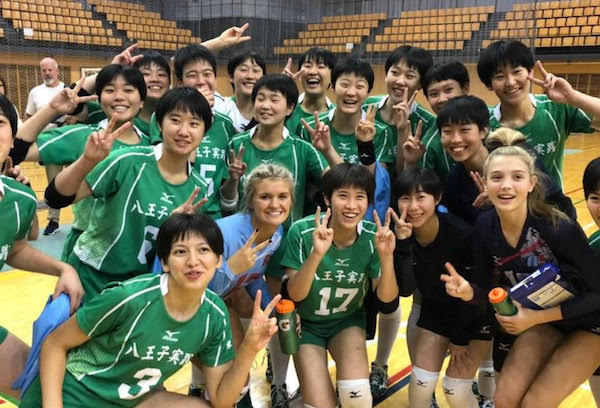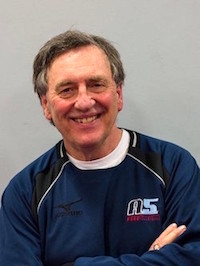Over Thanksgiving of this year, A5 was fortunate to travel to Japan with a select group of 16 athletes from three different age groups. The trip to Japan marked the club’s 9th international outing. A5 has travelled and trained three times in Puerto Rico, once in China, three times in Europe, once in Brazil, and now once in Japan.
Every trip was remarkable and changed the lives of the players, the coaches and staff, and the families of the athletes as well. It is simply stunning to return to our home gym and witness the growth both on and off the court of those athletes that have participated in these extraordinary opportunities.
Trip Itinerary
- The trip was a total of 11 days, with two of the days dedicated to travel. Click HERE to view our detailed itinerary.
- The mix of four matches and three training practices was perfect. Our athletes actually got to be inserted into their regular practice with the Japanese athletes. It was pretty amazing to see how they all communicated and how seamlessly our athletes were integrated into what they were doing.
- We played matches against two college teams and two high school teams. We trained with two college teams and one high school team.
- The trip cost between $3500-$5000 per person, and this is the same for any international trip our club has taken. Typically we take 4 coaches and at least one chaperone. Coaches pay a reduced amount. Chaperones cover their own costs. This does not include personal spending money but it does cover everything else.
- Kudos in the extreme for Cory Solomon who led our trip and Bring it USA, the organization that we use for our international training opportunities.
A5 has a Vlog that shares their day by day experience, and also includes video from training, travel and sight seeing. The video below is part 5 in a 5 part series.
Training and Gym Environment
We were able to bring back distinct drills and training methodology that we immediately inserted into how we work with our athletes.
- The idea of everyone having a job. When we train and compete against each other we always have two line judges from each team working. The other players are shagging balls or have some other specific work to do. Being diligent about this takes discipline and attention on our part. We are really committed to this in order to bring more focus from the coaches, as well as the players, during the time we are in the gym training.
- The next is do to as much player entry and drill initiation as possible. We see this as a cumulative venture. It was astounding to witness how dynamic the athletes in Japan were at running many of the drills executed while we were in the gym with them.
- One technical skill we have employed immediately is related to attack and arm swing. We are now asking the athletes to toss a relatively short toss with topspin with their non-dominant/non-hitting hand when initiating pepper. Their elbows are all the way back when the ball is tossed. When striking the ball we talk about accelerating their wrist and forearm through the ball and not following through a ton. Rather we want their follow occur naturally. More wrist, less arm. We are trying to create more ball speed and better hand contact.
Key Components of Japanese Training
- All of the volleyball athletes in the country have the same training cycle. We were there during the technical, repetition driven portion of their cycle. Since they train year-round and practice 25-30 hours a week they are able to spend an enormous amount of time on all aspects of the game; technical, tactical and competitive.
- Many hours of training. The number one high school team in Japan practices 34 hours per week. This includes two 7 hour days and 5 four hour days, practicing 7 days a week. The other teams practice 6 days a week. This include the one college team we played that was an Ivy League equivalent university.
- Everyone has a job. There simply are no wasted moments in the gym. Everyone is doing something the entire time. We were fortunate enough to play or train with the top three high school teams in Japan.
- The majority of the drills are player run. Older players teach younger players the techniques of the game.
- Their system produces all-around players. While this comes as no surprise, it was remarkable to realize that their front court players play as well defensively as their back court players. And their back court players were just as skilled as the front court players in attacking. Unbelievable to witness.
- Their out of system play was the stuff of dreams. We played 20 sets. In those 20 sets, it is not an exaggeration to state that 100% of the balls that went into the net on their side were played out of the net and became an in-system ball. 100%. When one considers how much time and repetition it takes to produce this kind of performance in this area, it is just mind boggling.
- Limited errors on their part. There were at least three or four sets where the Japanese team made no unforced errors. No missed serves. Did not get aced. No balls were hit out. No mental mistakes we could discern. In any given set their unforced error total did not exceed 6.
For what it is worth we took a very talented, relatively experienced high-level group of club athletes. Many future D-1 athletes. All gifted. It was a humbling, yet inspirational, on court experience to say the least.
Our athleticism and size amazed them.
Their skill set and discipline in the way they played the game amazed us.
The trip, in all aspects, was nearly perfect. The girls were great. They were supportive of each other and got along fabulously. They did not complain when things were tough. Many of our days were 12-14 hours long. We averaged walking 8-9 miles a day. We travelled a ton, spending time in Tokyo, Osaka and Kyoto. The food was strange but marvelous at the same time. Our players paid attention and were timely. They competed like crazy. Just a great group all the way around.
The coaches, Gabe Aramian, Jing Hou, Scott Cioffari and myself learned so much. It was so exciting on so many levels. Our support folks, Rob Cason, Cassidy Cason, Denise Templeton and others were engaged and extraordinarily competent. Connor Lounsbury, in a first for A5, was our travelling social media person and his work on behalf of the club and the team in Japan was simply astounding. His work has had a major impact on our community. We were honored and thrilled with the response folks from around the country gave us as Connor filmed, blogged and helped tell our story. This is a practice we will continue to employ as we travel in the future.
Will we go to Japan again? Yes. Absolutely, if at all possible. When? As soon as we can.
Still trying to absorb much of what we saw and did. There is so much more to be said. The insights gained were and are so powerful and ongoing. For now though, this is enough. See you on the court. Let us know if we can be of assistance in any way if you are planning to explore travelling and training internationally with your club. We would love to be of service. Click HERE to email Bob with questions about their trip.
For related reading for Club Directors click HERE. For related reading for Coaches click HERE. For related reading on travel click HERE.
About the Author
Bob Westbrook is the Founder and Chairman of the Board for A5 Volleyball, a long-time JVA member club in Atlanta, Georgia. His list of accomplishments includes coaching at the NCAA Division I college level for several colleges. He also founded the highly successful Front Range Volleyball Club in Colorado. Bob has brought national volleyball attention and prominence to Atlanta as his club is ranked in the top five clubs in the country year after year. His teams have succeeded nationally at the club level and his players continue to have success at the college level. Bob’s 2008 18-1 team won the USAV National Division Championship in Dallas and his 2011 18-1 team earned the first-ever 18 Open bid out of the Southern Region.













